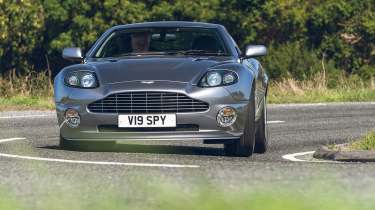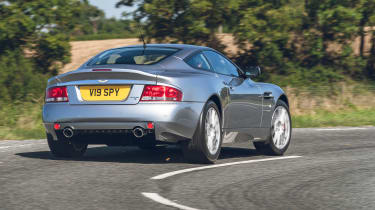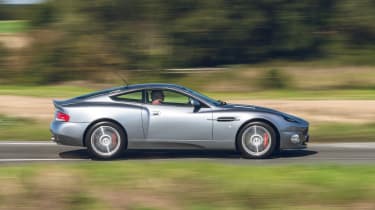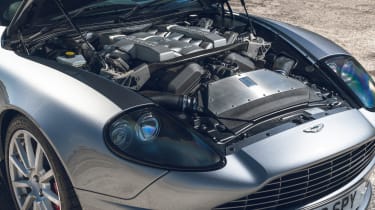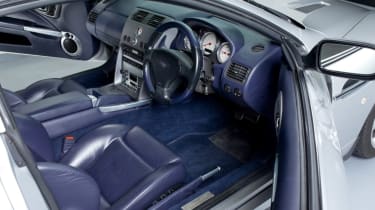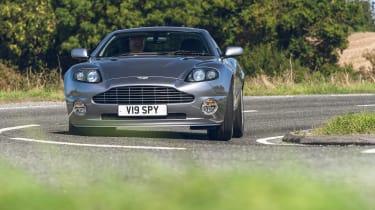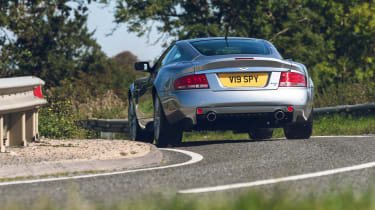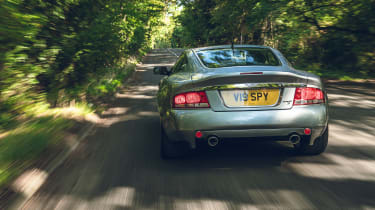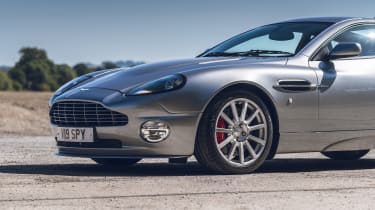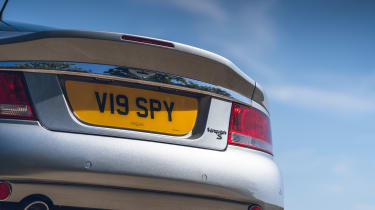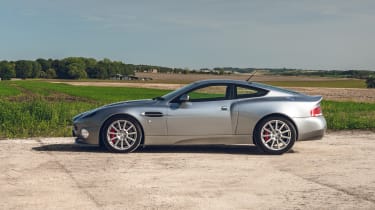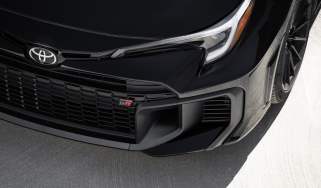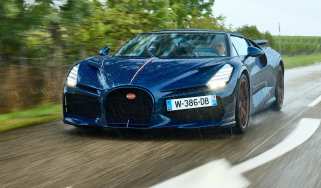Aston Martin Vanquish (Mk1, 2001 - 2007): Britain's answer to the Ferrari 550
One of the most significant of all Astons, the Mk1 Vanquish remains a brilliantly enjoyable driver’s car and an affordable one too
It’s difficult to understate the impact the V12 Vanquish had at Aston Martin when it launched in 2001. Ian Callum’s styling set the template for a generation of Aston Martins to follow, and you can still trace its bloodline in the current models, not just because the Vanquish name still exists, but conceptually and visually too. It’s almost like someone flipped a switch at the turn of the millennium: the Aston Martin story can now be written pre-Vanquish and post-Vanquish.
Give or take one or two details, its specification still looks modern today. The first-generation Vanquish is built on a Lotus-style extruded and bonded aluminium structure with carbonfibre reinforcement, uses aluminium panels, features a paddleshift transmission (albeit an automated manual like the others here, rather than a dual-clutch or today’s ubiquitous ZF eight-speed) and features not a single grain of wood in its cabin – though the Aston ‘waterfall’ dashboard design, which started here, is more of a polycarbonate cliff face and not one of the Vanquish’s stronger features.
> Aston Martin V8 Vantage (2005 - 2017) – Aston’s ‘baby’ aimed squarely at the Porsche 911
The engine was a development of the V12 that had latterly been installed in the DB7 Vantage, an all-alloy 5.9-litre, 60-degree unit making 460bhp at 6500rpm in its earliest form, but quickly pushed to 520bhp for the Vanquish S that debuted in 2004. Even considering the styling, the V12 was central to the car’s appeal, with an orchestral exhaust note that came to define Aston Martin’s sound signature over the coming decades – a philosophy that means today’s turbocharged Vanquish has the measure of a naturally aspirated 12 Cilindri for aural appeal.
The birth of the Vanquish
November 1997 and a cold, grey morning at the Millbrook proving ground. A secret Aston Martin concept is parked at the base of the famous Hill Route. It’s here for a photo op with Ford president and CEO Jac Nasser, Aston being part of the Blue Oval’s much-vaunted Premier Automotive Group. Also in attendance are Aston CEO Bob Dover and designer Ian Callum, both keen to hear Nasser’s verdict. But first, with the photo op bagged, Jac wants to go for a drive.
More reviews
Reviews
- Aston Martin Vanquish 2025 review - Britain’s Ferrari 12 Cilindri rival
- Aston Martin Vanquish Volante 2025 review – Ferrari 12 Cilindri Spider rival impresses
- Aston Martin Vanquish (2012 - 2018, Mk2): a V12 super GT great
- Aston Martin Callum Vanquish 25 by R-Reforged 2022 review
- 2019 Aston Martin Vanquish Zagato Shooting Brake review
- Aston Martin Vanquish Zagato review
- Aston Martin Vanquish S review
Unlike many a show-car mock-up, Project Vantage, as it’s known, is fully functioning – up to a point. Under the bonnet is a 5.9-litre V12 engine originally built for a Ford supercar concept but now earmarked for a potential starring role in future Aston road cars. It’s connected to a paddleshift automated manual transmission, another Aston first, but the rest is pure show-car: a glassfibre body perched on a one-off fabricated aluminium chassis, with race-car-style pushrod suspension. It’s been built to be driven – but not at the speeds that quickly ensue.
Nasser sets off, Bob Dover passengering nervously, and it’s soon clear that the Ford man is driving considerably faster than Project Vantage’s creators envisaged. When he pulls back in, the unique, machined-from-solid magnesium wheels have sunk up into the arches, the bespoke suspension’s aluminium pushrods unable to withstand the cornering forces. Oh, and it’s due to be packed up and shipped out to Detroit the next day…
As we now know, it would all end happily. And, crucially, Nasser was totally won over. Hard-nosed businessman though ‘Jac the Knife’ was, he was also famously a car guy, and he was responding to Project Vantage in a purely instinctive way. He instinctively knew this was how an Aston Martin should look and feel, that this was a template for the future of the marque. And, of course, he was proved absolutely right.
Renamed V12 Vanquish, the new flagship would be a hit with both press and customers alike. Moreover, it would establish a new design language for the Gaydon era of Astons that followed – cars like the DB9 and V8 Vantage – and its innovative construction would lead directly to the VH platform that would underpin the next 20 years of production. It was nothing less than the start of Aston Martin’s modern era.
But it wouldn’t happen overnight. It wasn’t until summer 2000 that the production-ready Vanquish was revealed and 2001 before we drove it, and in the intervening years it had changed… hardly at all. Or at least that was what at a casual glance told you; in fact just about every panel was subtly different; the bonnet line a little higher, the wings pulled out a touch; new lights front and rear. The construction, though, was radically different, with an innovative (partly Lotus-developed) platform that combined extruded, bonded aluminium with a number of carbonfibre elements. But the lines and proportions that so captivated Jac Nasser and everyone else when Project Vantage first broke cover were still very much present.
Fast-forward a quarter of a century (no, I can’t believe it either) and the Vanquish still has the power to stop you in your tracks. I’m at Hatfield-based Aston specialists Nicholas Mee & Co, who have kindly provided the example you see here to top up the memory banks. It’s a Vanquish S, the upgraded model introduced in 2004, and this 2007 example is one of the last 100 built. In special-order Grigio Titanio, a Ferrari colour, and with a mere 23,000 miles on the clock, this former concours winner is about as good as you’ll find. The colour’s also pretty close to the Tungsten Silver of Bond’s Vanquish as it appeared in 2002’s Die Another Day (though I might advise a different number plate should you wish to play out your 007 fantasies).
What the Vanquish has always had is presence. The contemporary DB9 and Vantage are both gorgeous shapes, but by comparison they look smoothed over, a touch more homogeneous, whereas the Vanquish looks and feels more exotic. Its lines have a bit more aggression, more attitude – more muscle definition.
Comparative rarity adds to the exoticism. Across all versions, the total built was 2578. A sizeable number compared with previous Newport Pagnell-built cars – but not compared with around 16,000 DB9s and even more ‘VH’ Vantages, which is why glimpsing one on the road, in the wild, always has you looking twice.
The impression of something hand-tailored continues inside. By the 2006 model year, Aston had banished some of the more jarring details of the early cars – the more obviously borrowed switchgear, for example, now swapped for Vantage/DB9 items – but retained some of the more endearing features, such as the polished aluminium door spars with their AM script. It all feels a little more bespoke than the Gaydon cars – a reminder that it was the last model largely hand-built in the old factory at Newport Pagnell. Among the details, the pale cream instrument faces are noticeably easier to read than the Gaydon cars’ chronograph-style dials, the revs reading to 7000, the speedo to 200mph…
Engine, gearbox and 0-62mph time
With the launch of the S in 2004, peak power had jumped from 460bhp to 520bhp thanks to the attentions of Cosworth, and while the 0-60mph time was practically unchanged (evo recorded 4.9sec, against AM’s claimed 4.6), the official top speed was up from 190 to a headline-grabbing 201mph. Whether anyone other than a factory test driver on a closed, banked circuit ever achieved that was a moot point then and certainly is now. But it all added to the Vanquish legend.
You’ll care even less the instant the 5.9-litre V12 catches. There are plenty of other applications of this magnificent engine, but it had unique intake and exhaust manifolding for the Vanquish, and while it sounds great in a DB9 or a V12 Vantage, it’s somehow more visceral, more vocal, more vital in the Vanquish. Aston Martin went to considerable lengths to get the sonics they wanted. As Bob Dover later revealed: ‘We recorded V12 sounds from a Ferrari and a Lamborghini on a cassette machine and made it sound like that!’
The Vanquish was famously the first Aston with an automated manual transmission and paddles, the system dubbed ASM (standing for Auto Shift Manual). Essentially it was a six-speed manual Tremec transaxle with electro-hydraulic clutch actuation, thus doing away with the clutch pedal. The ratio-swapping in early cars left plenty to be desired in terms of both speed and smoothness, though by the time the S came out there had been tweaks to both hardware (magnetic rather than analogue gear position sensors) and software to make it more acceptable.
Pull back on both paddles to select neutral, then pull the right-hand paddle to select first and you’re away. You can put the car in full auto mode, but it feels happier being manually shifted. Happier, but not completely chuffed. Early road tests highlighted how it was possible to smooth the shifts by backing out of the throttle just a touch on up-changes, and that still applies, even in a late Vanquish S.
To be honest, it’s not the gearchange that’s dominating my initial thoughts though, rather the feeling that I’m sitting a touch too high, partly because the instrument binnacle itself is set relatively low to the rest of the facia. It feels odd at first, but it dissipates the further you drive, helped enormously by the fact that you feel so connected to the car, both through the steering and through your backside.
Ride and handling
The Vanquish rides well, in a loose-limbed way where more recent Astons feel more tightly tied-down. Sitting on relatively modest (by current standards) 19-inch wheels and wearing tyres that actually have a discernible sidewall (Michelin Pilot Super Sports on this car, 255/40s at the front, 285/40s on the back) certainly helps the secondary ride, too…
Even in the more tightly suspended S, there’s quite a bit of initial give in the suspension as you load it up – considerably more than in a contemporary Vantage or DB9. So it rolls a touch more and doesn’t quite have the same sharpness of response. But this calmness in the ride and the steering is true to its GT nature. And you soon discover that when you push it a little harder you uncover a real depth of composure. Even better, it feels entirely natural as it shimmies its hips at the exit of a corner – everything relayed back to the driver in a rich stream of feedback from both ends of the car.
Among the changes for the S – improved gearshift, that power boost, uprated suspension and quicker steering – were bigger Brembo brakes. Those of the early car were a little marginal, given the weight and performance, but these were a marked improvement. The pedal has a slightly soft initial response that’s somehow in keeping with the rest of the dynamic package – everything slightly cushioned – but again they deliver when needed. This is on the road, of course – if you want an Aston for trackdays, it’s probably fair to say there are better alternatives.
And that’s mainly because despite its largely aluminium construction the Vanquish was and is a heavy car. Bob Dover later admitted it was built primarily for strength – the same example was used for front, side and rear impact tests – and they didn’t have time to reduce the weight as much as they would have liked. (Talking of strength, the carbonfibre windscreen frame was there to pass the convertible roll-over test, though Aston didn’t build a convertible in the end. Zagato did, and it looked terrific, but it remained a one-off.)
With a kerb weight of 1875kg and a power-to-weight ratio of 282bhp per ton, outright performance is, unsurprisingly, little to write home about in today’s super-tourer landscape. But it’s strong and urgent enough to be engaging, the power swells pleasingly, and that soundtrack is very special indeed. For the full orchestral effect you need to sustain the throttle past 5000rpm, which is when the full string and brass sections join in. No V8 can match that.
The gearbox remains its weakest aspect. The changes can be smoothed, through finessing the timing and degree to which you feather the throttle, but it’s still a touch more ponderous than you’d ideally like. I reckon I could learn to live with it; there’s a kind of satisfaction to be derived from executing smooth changes, both up and down the ’box – approaching T-junctions and roundabouts it’s much slicker if you paddle through the down-changes yourself.
But there is another option (two in fact) if you’ve set your heart on a Mk1 Vanquish. At least one specialist has offered a conversion to a fully automatic gearbox. Better yet, shortly after production ended at Newport Pagnell, the renamed Aston Martin Works developed a conversion to a traditional manual with a stick shift and three pedals. By a stroke of luck, Nicholas Mee & Co have another pristine, low-miles Vanquish in stock, this one a 2005 car with the Works conversion. It should make for a fascinating comparison.
The gearbox was physically the same Tremec unit but with all the electronics and actuators stripped away and some minor internal changes. The engineers then created an aperture in the central carbonfibre tunnel to allow a lever to be pushed through, while the driver’s footwell was reconfigured to include a clutch pedal, the whole thing beautifully trimmed so that it blended seamlessly.
Around 100 cars have had the conversion over the years, at a cost of around £20,000. Which is a substantial sum, but the whole thing is very well executed – as you’d expect for what is, in effect, a factory conversion, developed by some of the engineers who built the car originally.
The clutch is quite stiffly sprung and the initial shift into first is slightly gristly, but once everything’s warmed through and you’re focusing on the road rather than the mechanism, the stick can be palmed around the gate with pleasing ease. What’s more, you immediately feel more connected, more in control, more involved. It subtly changes your perception of the Vanquish. For a fleeting second, you can almost kid yourself you’re driving a sports car – especially since the pedals are well-positioned to pivot your braking foot and give the throttle a squeeze on down-changes.
Get too carried away, though, and the Vanquish’s weight and slightly cushioned responses are there to remind you that, while it is many things, a sports car it ain’t. The Vanquish does things its own way – and it’s all the better for it. The manual just adds another layer of driving enjoyment to what is already an immensely enjoyable car.
There’s something very noble about the Vanquish. It’s the blue-blooded supercar, a machine that could only have been made in England. There’s just enough of the hand-crafted about it to connect with its Newport Pagnell roots, but at the same time it’s tangibly a giant stride on from the DB7 and the old Virage-based monsters that came before it.
It is the consummate GT. Every time you slip in behind the wheel, you start thinking about road trips: Le Mans, perhaps, or even further afield. And whatever your destination, you’d always take one last lingering look back. Good call, Jac.
Aston Martin Vanquish Mk1 buying guide
What to look out for
Predictably, mileage, service history and condition count most when buying an original Vanquish in 2024, but specification also plays a part. The Linn audio system that replaced the original Alpine hi-fi for the 2003 model year is desirable, as is full leather (some Vanquishes have Alcantara centre panels on the seats), while 2+2s are slightly more sought-after. 007-spec Tungsten paint adds value; conversely, dark blues and greens are not so saleable.
A really worthwhile option was the Sports Dynamic Pack, available from 2003, which added uprated suspension and brakes. The Vanquish S, introduced in 2004 (from chassis 1506), incorporated the handling upgrades, along with a new aero package, an improved gearshift and a power increase to 520bhp. ‘The S is a better car,’ says Paul Spires, ‘but it’s worth noting that an early car can be uprated to what is effectively S specification.’ Works has also converted a number of Vanquishes to manual transmission, using the six-speed Tremec unit from the DB7 GT.
‘You do need to tread carefully,’ says Spires. ‘The thing is, Vanquishes were in the doldrums for a while, and many cars weren’t looked after as they should be. Those cars can take a lot of money to bring back into good order. And the way it’s constructed means restoration can be expensive. It’s a flagship Aston Martin, you can’t get away from it, and the running costs are those of a £180,000 motor car.’
So, how to find a good one. A full service history by reputable specialists is the first box in need of ticking. Ideally Vanquishes should be serviced every six months or 7500 miles; if a car’s had anything less than an annual service it should certainly put you on your guard. If in doubt, have your potential purchase inspected. Works offers an inspection and road test report for £720 plus the cost of transporting the car to Newport Pagnell; several of the other Heritage specialists like Nicholas Mee offer a similar service. It’s possible to buy a warranty, too.
The good news is that the V12 engine is very strong, and serious faults are rare. The most common problem is with the coil packs, which suffer both from heat damage and occasionally from water ingress causing shorting. It’s an expensive job to replace them, and always best to do a bank at a time (budget around £600). So check the engine pulls cleanly and smoothly. Any misfiring points to problems.
Potentially the most serious issue is oil consumption caused by the engine ingesting its own oil vapour because the reed-type valves in the breather system have stuck open. A low oil level could eventually lead to starved big end bearings at the back of the engine. So look inside the air filter for a heavy oil deposit; anything more than a light misting could spell trouble.
Don’t be put off by the automated manual – properly set up and driven with a little sensitivity, it’s a decent system. The Magnetti Marelli hardware sits on the back of the transaxle, providing electro-hydraulic actuation of the gearchanges. ‘Early cars had analogue gear position sensors, which can wear, which is when you can get problems,’ says Paul Spires. Later cars (chassis 600 onwards) had magnetic sensors, which are much more robust. Most early cars have had them retro-fitted when the clutch has been replaced. The shift has benefited from software updates over the years, too.
Neal Garrard, of Nicholas Mee & Co, makes the point that the system benefits from crisp handling so as not to overwork the clutch plate (budget around £4k if a new clutch is needed). It’s something those familiar with the car do automatically, along with selecting neutral whenever it’s likely that the car will be stationary for more than a couple of seconds.
Unsurprisingly, clutch wear varies hugely depending on driving style. Clutches can last as few as 15,000 miles or as many as 40,000. On the test drive you’re looking for a nice crisp pull-away and a crisp change, with no slip, no untoward noises and no serious vibrations. A whistling sound as you pull away suggests spigot shaft bearing wear, which is a £2000 repair; £5000 if the shaft needs replacing too.
The standard brakes aren’t up to track-work but are fine for anything but the most extreme road driving. Cross drillings should be cleaned as part of a service; if they’re blocked it can lead to corrosion, particularly on the inner face.
Speaking of which, look for bubbling at the edges of the aluminium body panels, the first signs of electrolytic corrosion, which if it develops will eventually necessitate a respray. Also check the front wing strakes – they’re cast on some cars and also prone to bubbling (replacements cost around £300 each).
The single biggest problem with the Vanquish, though, is its steel front subframe. Water gets trapped between undertray and frame, causing rust. If it’s extensive it may require replacement (£5000-plus). So remove the tray and check. And also check the small steel bracket at the end of each sill. Corrosion here can spread through the mounting bolts and cause electrolytic reaction in the tub itself. The carbonfibre crash structure front and rear is visible underneath so check for signs of damage, though it is repairable.
So plenty to keep in mind, but a good Vanquish is well worth seeking out. Nicholas Mee & Co have no doubts about the Vanquish’s status. ‘In 25 years’ time we believe it will be seen as a significant turning point for the company, just like the DB4 was in the late 1950s,’ says Neal Garrard. ‘The DB7 was never quite accepted as a proper Aston – the hardcore never really took it to their hearts – but the Vanquish was the real thing.’
Choose wisely, and you’ll have one of the most significant Astons of recent times and surely a sound investment. But you’ll also have an Aston that still feels capable and useable, and one with an unmistakable presence, a real aura about it.
As Paul Spires says: ‘I was lucky enough to own one for a while. When you open your garage door and there’s a Vanquish there, you can’t help but smile.’ – John Simister
Owner's review – 'I bought one'
Owner Steven Behrens actually has two examples of the Vanquish in his stable, an early car and a later, concours condition Vanquish S, which joined a DB7 Vantage. For three cars powered by essentially the same engine, Behrens says they have a remarkably different feel – all still Aston Martins in their own way, but each with its own unique personality.
‘The S has all kinds of improvements over the early car, and it’s much more refined – it feels almost like a new car to drive. My earlier car has a significant number of upgrades, and is a little bit more raw, a little bit rough around the edges, but the Larini sports exhaust helps with that. You get the same kind of sound, just more of it – the extra feedback when accelerating is exhilarating. That said, the tighter gear ratios in the S, along with the extra power, give it quite a different feel too.’
And yes, just like the owners of the Ferrari and Lamborghini, Behrens pushes back on early criticism over the automated manual transmission. ‘If you’d asked me about the gearbox earlier, I’d have said it was difficult to get used to. But Steve Waddingham at the Aston Martin Heritage Trust put out a video with the original test driver to explain the best technique. The penny dropped and I changed my driving style – just a slight lift on upchanges is all it takes. If you drive it correctly, clutch life is hugely improved too – I’ve been told up to 40,000 miles.’
The general consensus is that upkeep of the Mk1 Vanquish requires a little more effort and expense than the more mainstream cars that followed in its wheeltracks. This shouldn’t come as a surprise, but a comprehensive service history from either a marque specialist or AM itself is essential with the Vanquish, as far back as you can go – Vanquish prices have drifted as low as £50k and owners picking up what they see as a bargain may be less inclined to embark upon money-no-object maintenance.
Behrens recommends owners – and potential owners – seek out a specialist such as v12vanquish.com. The original car’s relatively limited production run actually pays dividends since specialists can concentrate entirely on that model and may be familiar with it in a way that the usual Aston Martin servicing network is not. Certain parts can be as little as a fifth of the usual price too, massively cutting servicing costs.
In recent years, Behrens’ earlier car has needed its fuel pump replaced, but then as he points out, the earliest cars are now approaching a quarter-century old, and simple wear and tear is as much a factor as the car’s inherent foibles and limitations. Specification is important too – the S, being a newer car, doesn’t just have mechanical improvements but may be wearing its years a little better, while the desirability of earlier cars is boosted by the Sports Dynamic Pack (SDP) as fitted to Behrens’ car and 93 others and which takes them a little closer to S specification.
That V12 engine is admirably tough though; not immune to failing coil packs and oil consumption, but otherwise trouble-free. Thanks to the car’s aluminium construction you’re unlikely to find any holes, but minor corrosion can still leave the Vanquish looking untidy, and the one major component that is steel, the front subframe, can succumb to rust. A DB9 might be easier to run, but for the more involving driving feel, more striking styling and that vocal V12, it’s not a mystery why so many are drawn to the Vanquish.
Aston Martin V12 Vanquish Mk1 specs
| Engine | V12, 5935cc |
| Max power | 460bhp @ 6500rpm |
| Max torque | 400lb ft @ 5000rpm |
| Transmission | Six-speed automated manual, rear-wheel drive, limited-slip differential |
| Weight | 1835kg |
| Power to weight | 255bhp/ton |
| 0-60mph | 5sec |
| Top speed | 190mph |
| Price new | £160,000 in 2001 (£302,108 in 2025 money) |
| Price today | £45,000 - £115,000 |
